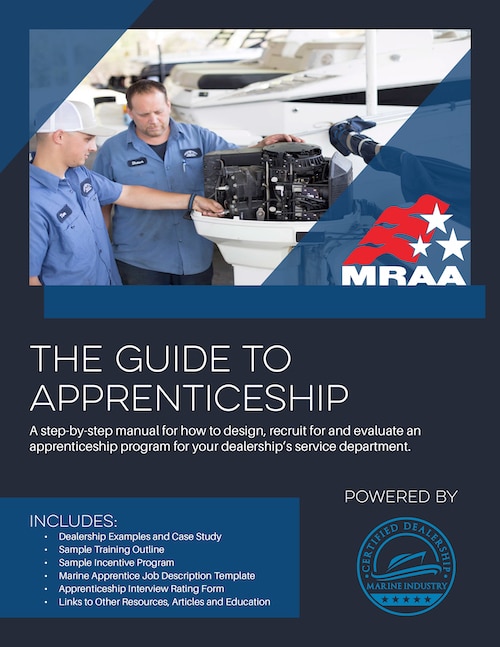• Using Apprenticeship as a Retention Strategy & Build Your Workforce
An MRAA blog by Wendy Mackie, Director of Workforce and Foundation Development

You are in competition for a workforce. Not only with those in the boating and water sports industries, but in all industries. Workers are looking for opportunities for upward mobility and the higher wages that come with it. Whether you are trying to grow your business or thinking you might need to trim back with a volatile economy, retaining those people who are good fits for your company’s culture should be a top priority.
If you Google the words “apprenticeship as a retention strategy,” hundreds of articles and statistics will appear, supporting that training programs, and apprenticeship specifically, increases staff engagement, morale and retention. It is also proven to enhance the culture of your dealership, sending a clear message regarding your company’s commitment to continuous education and its willingness to invest in the people who work there.
To put those statistics into a real-world context, I interviewed my brother, Steven, who has spent the better part of the last 20 years staffing and training production lines in manufacturing. Steven has a very matter-of-fact approach. We talked about the notion of apprenticeship as a retention strategy and how that has played out in his experience. Though there are clear differences between the needs of your dealership and that of a manufacturer, the workforce concepts are broadly applicable – and, in fact, you may be competing with manufacturers in your local community for employees. Below is an excerpt of our conversation:
Wendy: What have you found to be effective ways to retain workers on the shop floor?
Steven: Retention is connected directly to career path and salary. When you show people how they can earn more and provide those clear steps from the start, you get the retention.”
Wendy: A key principle in the apprenticeship model is structured learning toward promotion and wage gain. Is that what you are talking about?
Steven: Finding experienced talent is tough and expensive. When I am building a team, I look for those people who are motivated to work and grow. When I can show a potential hire clearly benchmarked skill attainment connected directly with wage increases, I take the guesswork out of what the applicant will earn and when they will be up for the next raise. It both helps to attract the right people and weed out those who would ultimately not be a good fit.
Wendy: It really does come down to what someone will work for and what you can afford to pay, right? What happens when the employee has learned all they can and the wage increases slow down? Will they leave?
Steven: When people know more, they want to earn more. They might eventually leave. People don’t typically stay in one place forever, and that’s okay. When you look at the bottom line, you may not really want them to. It’s important to have a workforce that can do the job at hand at the cost that is necessary to keep the customer coming back. It is our job [as an employer] to find that balance.
Wendy: Some business owners have said they don’t want to invest in training an employee if that employee is just going to go work for a competitor. What is your experience with that?
Steven: Training is critical to our ability to deliver a good product, and it is reflected in the final price we are charging the customer. We use training as a tool for recruitment and retention. However, with technology constantly changing, it is also a necessary part of remaining competitive in the consumer marketplace. It is a part of the company’s culture and its business model.
Regarding the person who will leave for a competitor after receiving training, that does happen. If you want to keep that person, you will need to figure out how to do that. It’s not just about wages. There are often other things you can provide to engage and retain a good worker. Perhaps more time off, flexible hours, additional training or a company car. It is also important to look at your business and make sure it is a place people want to stay.
Conclusion
By providing new hires with clear expectations for next career steps, you can build a stronger workforce for your business. Proper training through an apprenticeship program can create confidence and success for you and your new hire. Success boosts morale, leads to professional advancement and increases potential earnings. These career employees can then help you build your company’s culture; one that focuses on retaining employees vs. repeatedly rehiring new ones.

With two simple steps, you can take your apprenticeship program and your workforce to new heights.
- Download the MRAA’s “Guide to Apprenticeship” here (right). This step-by-step manual will help you design an apprenticeship program for your dealership’s service department or improve your existing one.
- Register for MRAA’s Dealer Week Conference and Expo to learn from subject matter expert and speaker Gloria Sinclair Miller, SHRM-SCP, about employee retention tactics. In “Rethink How to Engage & Hold Onto Your Employees,” Gloria shares real-world tactics for engaging and retaining your existing employees. This session also meets one of the 2023 Continuous Certification Requirements for Certified Dealers.



